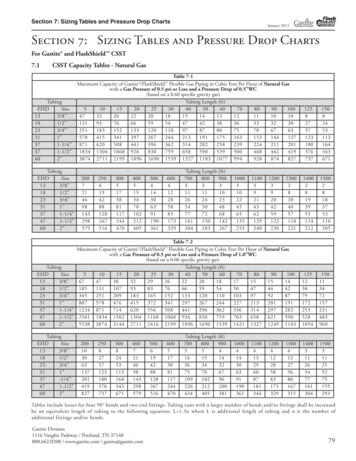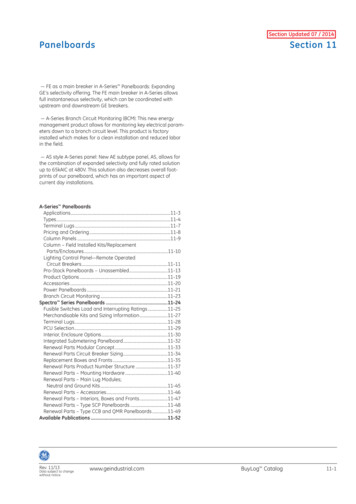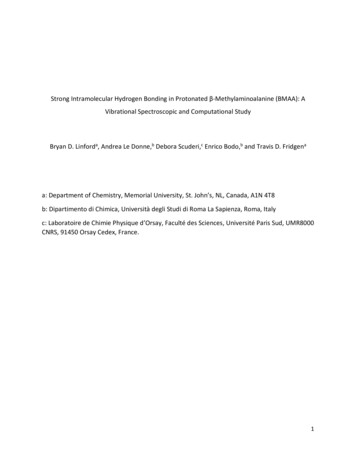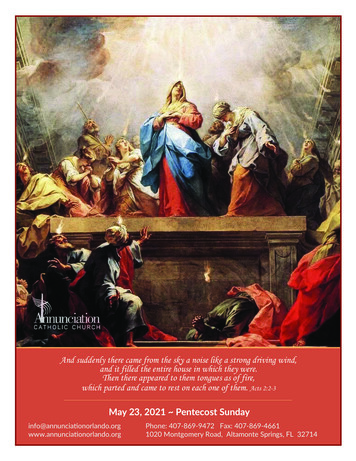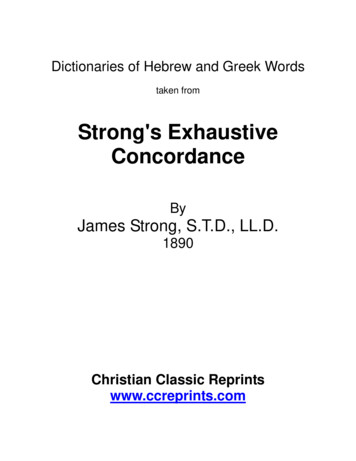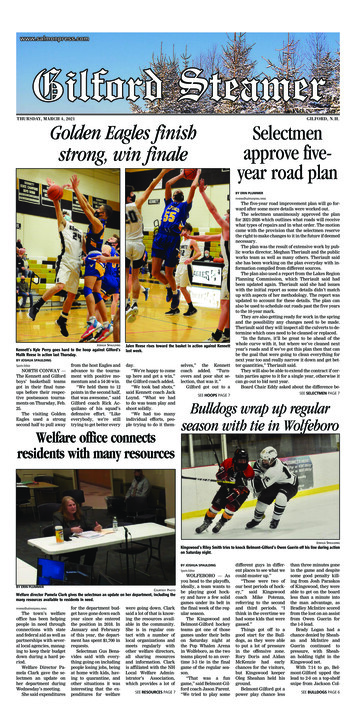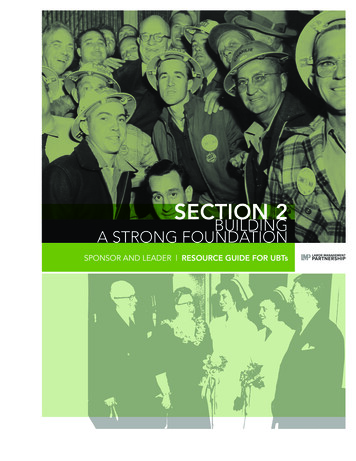
Transcription
SECTION 2 BUILDING A STRONG FOUNDATIONSECTION 2BUILDINGA STRONG FOUNDATIONSPONSOR AND LEADER RESOURCE GUIDE FOR UBTsSponsor and Leader Resource Guide for UBTs www.LMPartnership.org[ 2. 1 ]
SECTION 2 [ 2. 2 ]BUILDING A STRONG FOUNDATIONwww.LMPartnership.org Sponsor and Leader Resource Guide for UBTs
SECTION 2BUILDING A STRONG FOUNDATIONSECTION 2 BUILDING A STRONG FOUNDATIONIntroductionKaiser Permanente is a large, complex organization. It is helpful tounderstand the basic structure and how the various entities relateto each other, as well as the historical context. These things explainhow we became what we are today. And now, given the particularchallenges we face, it is equally important to understand why andhow we must transform in order to sustain our mission and valuesinto the future.This section contains information on the history and structureof Kaiser Permanente; the Case for Change—which explains thecurrent threats to our mission; the Value Compass—our guide toimproving organizational performance; unit-based teams—ourplatform for organizational improvement; and Partnership—theway Kaiser does business. This information will provide you with astrong foundation as you build your sponsorship skills to lead unitbased teams to success. Our members/patients, our communitiesand our entire organization look to UBT sponsors to create anenvironment where teams thrive, generate results and we transforminto what we need to become. We can’t do it without you!“The ultimate measure of a man is notwhere he stands in moments of comfort,but where he stands at times ofchallenge and controversy. ”Martin Luther King, Jr.Sponsor and Leader Resource Guide for UBTs www.LMPartnership.org[ 2. 3 ]
SECTION 2 BUILDING A STRONG FOUNDATIONOur Collective StructureWhat is Kaiser Permanente?At Kaiser Permanente, the way we deliver health care is different.We’re a health plan, a hospital system and a medical group,all working together—making it easier for us to give our membershigh-quality, coordinated and affordable care that’s convenient.Kaiser Permanente (KP) is America’s leading health care providerand not-for-profit health plan. The Kaiser Foundation Health Plan,Inc. (KFHP) and its regional operating organizations, KaiserFoundation Hospitals and the Permanente Medical Groups (PMG)are joined by the Coalition of Kaiser Permanente Unions (CKPU),which represents more than 95,000 coalition union employees.As a health plan, hospital system and medical group all workingtogether, Kaiser Permanente is able to deliver high-quality, coordinatedand affordable care to members and patients.KP currently serves 8.6 million members in nine states and theDistrict of Columbia. Kaiser Permanente has 167,000 employees,including 40,400 nurses, 14,600 physicians, 35 medical centersand 431 medical offices. In 2008, annual operating revenueswere approximately 40.3 billion.Our Three Constituencies:1. COALITION OF KAISER PERMANENTE UNIONSCO ALITION OFKAISER PERMANENTEToday, the Partnership covers 95,000 employees (about 80 percentof all union-represented employees at KP) in six international unionswith 29 locals who comprise the Coalition of Kaiser PermanenteUnions (CKPU). The Coalition of KP Unions bargains collectivelywith KP.The combined non-KP membership of these international unionsexceeds 6 million members. It is important to understand that mostof our partnership unions work with other employers in addition toKaiser Permanente. Also, each international and each local unionhas its own unique internal structures, adopted by-laws andcollective bargaining agreements they negotiate and enforce withmultiple employers.[ 2. 4 ]www.LMPartnership.org Sponsor and Leader Resource Guide for UBTs
SECTION 2 BUILDING A STRONG FOUNDATION OUR COLLECTIVE STRUCTURECKPU staff report to the executive director of the CKPU who in turnis directly responsible to a Board of Directors that is composed ofprominent national union leaders. The executive director also servesas the labor representative for the Labor Management Partnership.2. THE PERMANENTE MEDICAL GROUPSPermanente Medical Groups (PMG) are physician-ownedorganizations that provide and arrange for medical care forKaiser Foundation Health Plan members (or Group Health of thePuget Sound in Seattle) in each respective region through exclusivecontracts. Kaiser cannot contract with anyone else to providemedical care and Permanente cannot contract with any other healthplan/provider organization.The medical groups are for-profit partnerships or professionalcorporations. Each Permanente Medical Group contracts with theHealth Plan to be paid a fixed amount per member, per month,from the membership dues the Health Plan collects. The firstmedical group, The Permanente Medical Group, was formed in1948 in Northern California.Each medical group is autonomous from the others and hasits own board of directors. They do not report to a central governingbody or entity. The medical director for each PMG is elected by themedical group and not appointed by the board.The Permanente Federation, LLC, was formed in January 1997.It exists to help medical groups work collaboratively to provide highquality, affordable health care services through enabling ongoing,organizational transformation. The Permanente Federation works inpartnership with Kaiser Foundation Health Plan and the Coalition ofKaiser Permanente Unions on program-wide initiatives.The Federation reports to the Permanente Medical Groups and isgoverned by a five-person Executive Committee composed of fourExecutive Medical directors (from four regions) and the Federation’sExecutive Director.3. KAISER FOUNDATION HEALTH PLAN AND HOSPITALSThe Kaiser Foundation Health Plans (KFHP) are non-profit,public benefit corporations that contract with Kaiser FoundationHospitals and medical groups to provide services. In regions that areSponsor and Leader Resource Guide for UBTs www.LMPartnership.org[ 2. 5 ]
SECTION 2 BUILDING A STRONG FOUNDATION OUR COLLECTIVE STRUCTUREnot hospital-based, they may contract with non-Kaiser hospitals. TheHealth Plans are the health insurance component of the organizationand are therefore the income-producing arm of Kaiser Permanente.Each region has its own health plan company.Kaiser Foundation Hospitals (KFH) is a non-profit, public benefitcorporation that owns and operates community hospitals in threestates: California, Oregon and Hawaii. The corporation owns outpatient facilities in all KP regions; provides or arranges hospital services;and sponsors charitable, educational and research activities.Kaiser Foundation Health Plan and Hospitals has a single board ofdirectors that is the ultimate governing body. The current chairmanof the board and chief executive officer of Kaiser Foundation HealthPlan and Hospitals is George C. Halvorson. Each region is headedby a regional president who reports to a member of the nationalleadership team, headed by Mr. Halvorson.The 2005 National Agreementexpires in September 2010, atwhich time a new partnershipagreement will be negotiated.A summary of the 2005National Agreement can be foundat: 05 national agreementsummary.pdf.Labor Management PartnershipKaiser Permanente and the Coalition of Kaiser Permanente Unionscreated the Labor Management Partnership (LMP) in 1997as a way to transform the relationship between unions and theorganization—in essence, returning to the cooperative spiritbetween the company and its union employees that existed atthe company’s founding.The Partnership is an operational strategy for engagingphysicians, managers and front-line workers in achieving highorganizational performance results by involving employees andunions in decision making at every level.The LMP is governed by the Labor Management PartnershipStrategy Group, which is composed of the regional presidents,a subset of the KFHP/H National Leadership Team, representativesfrom the Permanente Medical Groups, the Permanente Federation,the Office of Labor Management Partnership (OLMP) and theCoalition of Kaiser Permanente Unions (CKPU).National AgreementThe National Agreement (NA) is a contractual agreement thatoutlines how our three constituencies will work together to makeKaiser Permanente a high-performing organization. The agreement[ 2. 6 ]www.LMPartnership.org Sponsor and Leader Resource Guide for UBTs
SECTION 2 BUILDING A STRONG FOUNDATION OUR COLLECTIVE STRUCTUREalso addresses issues within the legal scope of representation,including wages and hours, working conditions and proceduresto be used when parties differ in their interpretation of any of theprovisions of the National Agreement. The current agreement,established in 2005, is the result of an interest-based bargainingprocess that involved more than 400 workers, physiciansand managers.The 2005 NA is considered to be a “living agreement,” which meansthat the provisions it covers can be discussed at any time.LMP TrustThe Partnership Trust was established to fund labor managementadministration and partnership activities and it pays for about 98percent of the costs for Coalition staff. The Trust is overseen by theLMP Strategy Group.Funding for the Trust comes from two sources: each CoalitionUnion employee defers .09 per hour of their wages—depositedinto the Partnership trust—for a total of more than 14 millionannually; Kaiser Permanente contributes more than 7.5 million tothe Trust, along with some additional funding for positions that workdirectly with the Partnership. Contributions to the Partnership Trustfrom KP and Coalition Union members totaled more than 22 millionin 2008.Workforce Development TrustsThree rules forhuman relations:“Mutualacceptance,recognition andconfidence ineach other.Honesty andintegrity inour dealingstogether.We mustunderstandeach other.”Henry Kaiser,Kaiser Permanente founderThe Kaiser Permanente Workforce Development Program is fundedby two trusts, each governed by a board composed of an equalnumber of union and management trustees:The SEIU UHW-West and Joint Employer Education Fundoffers educational and training opportunities to all SEIU membersemployed by Kaiser Permanente in California, Colorado, Oregonand Washington.The Ben Hudnall Memorial Trust, named after a prominentUnion Coalition negotiator and activist, provides workforcedevelopment services for all members of UFCW, OPEIU, UNAC/UHCP-AFSCME, OFNHP-AFT, ILWU, IFPTE, USW, KPNAA, IBT,ONA (Ohio) and the ONA (Oregon).Sponsor and Leader Resource Guide for UBTs www.LMPartnership.org[ 2. 7 ]
SECTION 2 BUILDING A STRONG FOUNDATIONWhy Do We Need To Change?A Case for ChangeKaiser Permanente's historic mission and model of care—our uniquesystem of high-quality, affordable care—has served our membersand communities well for more than 60 years. But our mission isthreatened by current economic realities, competitive pressures andhealth care public policy. It is time for change.1.WE HAVE a historic mission as our country’s first and largest non-profit integrated healthcare delivery system founded by working people for working people.2.WE FACE unprecedented market threats, economic changes and public policy issues.Our mission is at risk.3.WE’RE CHANGING to meet these challenges—and that means every worker,manager and physician will think and work differently in their day-to-day jobs.All of us, regardless of our role in the organization, are looking athow we need to work differently to provide the best quality, the bestservice, the most affordable care and become the best place towork—for ourselves, our members and the communities we serve.Key Tip!DOING OUR WORK WELLDOING OUR WORK BETTERProfessional Knowledge,Professional Knowledge,Skills, ValuesSkills, ValuesThis means every day that wehave two jobs: to do our work welland to figure out how to do thework better.Deliver High-QualityImprove Processes andPatient CareSystems in HealthFor more information, seewww.LMPartnership.orgINCREASED VALUE FOR OUR MEMBER/PATIENTS,COMMUNITY AND KAISER PERMANENTE[ 2. 8 ]www.LMPartnership.org Sponsor and Leader Resource Guide for UBTs
SECTION 2 BUILDING A STRONG FOUNDATION WHY DO WE NEED TO CHANGE?A Casefor Change Activity—Stating Your CaseTOOL: A Case for Change Activity—Stating Your CaseUse this activity to think about what you will say to support the Case for Change at your workplace.This tool will help you use everyday workplace opportunities to communicate about transformation.For each of the key points, write in your own words what the key message means. Then, practicestating what you would tell your UBT or co-leads about the Case for Change.KEY MESSAGEIN YOUR OWN WORDS, WHAT DO YOU THINKTHIS MEANS?WE HAVE a historicmission as our country’s firstand largest non-profit integratedhealth care delivery systemfounded by working people forworking people.WE FACE unprecedentedmarket threats, economicchanges and public policyissues. Our mission is at risk.WE’RE CHANGING to meetthese challenges—and thatmeans every worker, managerand physician will think andwork differently in their day-today jobs.For the last key point, what will this look like at your workplace?Sponsor and Leader Resource Guide for UBTs www.LMPartnership.org[ 2. 9 ]
SECTION 2 BUILDING A STRONG FOUNDATIONWhat Direction Will We Take?The KP Value Compass—A Tool to GuideYour DecisionsThe Value Compass sets the direction for improving organizationalperformance with a focus on the health plan member/patient.The points on the compass make Kaiser Permanente’s path tosuccess clear.As an organization, and in our unit-based teams, we must:[ ]Put the health plan member/patient at the center of every decision[ ]Set the standard for customer service[ ]Give unrivaled quality care[ ]Create the best place to work[ ]Provide affordable coverage“Accountability andperformance are notdriven by managers,they’re driven by ourcommitment to carefor people.”John Guffey,Pharmacy Manager, NW[ 2. 10 ]www.LMPartnership.org Sponsor and Leader Resource Guide for UBTs
SECTION 2 BUILDING A STRONG FOUNDATION WHAT DIRECTION WILL WE TAKE?Points of the Value Compass1.Provide unrivaled quality of care.Members/patients are involved in managing wellness insteadof only treating illness.4.Set the standards for serviceto members and patients.2.Provide affordable, high-qualityhealth care services to improvethe health of the members andcommunities we serve and to3.grow KP membership.The work environment is characterized by collaboration,inclusion and mutual trust.Each person engages his/her full range of skills, experience andabilities to continually improve service, care and performance.Sponsor and Leader Resource Guide for UBTs www.LMPartnership.org[ 2. 11 ]
SECTION 2 BUILDING A STRONG FOUNDATION WHAT DIRECTION WILL WE TAKE?KP Value Compass ActivityTOOL: KP Value Compass ActivityUse this activity to determine how well your teams are doingbased on the points on the Value Compass and to identify keyareas that require improvement.How to Use1. Review the Value Compass with your co-leads. Explain the keypoints on the Compass and discuss what they mean if yourYou may download copies ofthe Value Compass at theco-leads are not familiar with them.LMP website:2. Ask your co-leads to write down answers to the questions below.www.LMPartnership.org/3. Discuss the answers with your co-leads to identify opportunitiestransforming/valuefor performance improvement and begin planning priorities forcompass.html.their UBTs.1. How is your work unit performing in each of the points on the Compass?2. What results do you want to achieve in each of these areas?3. What can your UBT do to achieve those results and be more patient- and member-focused?[ 2. 12 ]www.LMPartnership.org Sponsor and Leader Resource Guide for UBTs
SECTION 2 BUILDING A STRONG FOUNDATIONHow Will We Make The Change?Partnership—The Way Kaiser PermanenteDoes BusinessWHAT PARTNERSHIP MEANSKey Tip!Unit-based teams enable fullerToday, we are challenged by cost and competition as never before.We can and must transform Kaiser Permanente, so we can leadthe nation toward the transformation of health care itself. One waywe are changing is through our Labor Management Partnership,which offers us a model for patient-centered care delivered throughunit-based teams (UBTs).integration at the work unit whenfrontline workers, managers,physicians—individuals withdifferent job functions andexperience—work collaborativelyto solve problems.Change must occur at every level to move the whole.The transformation of KP into a high-performing, market-leadingorganization focused on the needs of our members and patientsis possible only with the involvement, influence, accountabilityand day-to-day work of all.KEY CHARACTERISTICS OF HIGHEST-RATEDPARTNERSHIPS»» Trust»» Plan Together»» Role Clarity»» Mutual GoalsThrough UBTs operating in partnership, employees throughoutthe organization have the opportunity to make decisions and takeactions to improve performance and better address member andpatient needs.“In times of change, trust-buildingbehaviors are positively related to anorganization’s capacity for change.Conversely, trust-breaking behaviorsare associated with a decrease incapacity for change.”Margaret M. Rudolf, PhD, consultantSponsor and Leader Resource Guide for UBTs www.LMPartnership.org[ 2. 13 ]
SECTION 2 BUILDING A STRONG FOUNDATIONKey Tip! HOW WILL WE MAKE THE CHANGE?UBTs—The Platform for TransformationWHAT IS A UNIT-BASED TEAM?Our goal is to elevate member/patient care from being a matterof individual effort to making it thebasis for team decision making andperformance improvement.PARTNERSHIP IN ACTION. A unit-based team (UBT) is anatural, local work group made of workers, physicians and managers,who work collaboratively to solve problems and enhance quality fortangible and quantifiable results. Together they are accountable forimproved performance.By 2010, everyone at Kaiser Permanente who is representedby a coalition union—and every physician and manager whoworks with them—will be part of a unit-based team. UBTs will bethe operational platform throughout the KP system. Performanceimprovement will be driven by unit-based teams who workcollaboratively to solve problems and enhance quality fortangible results.EXAMPLE: A small unitwith a total of six team members[including physicians, providers,managers and frontline staff]engages everyone in decisionsthrough huddles and regularUnit-Based Teamstaff meetings.Team members conduct smalltests of change to improveperformance.[ 2. 14 ]www.LMPartnership.org Sponsor and Leader Resource Guide for UBTs
SECTION 2 BUILDING A STRONG FOUNDATIONWhat Can We Accomplish?Partnership brings managers, frontline workers and physicianstogether to make full use of the expertise of each group and eachindividual. These different perspectives help to bring about solutionsthat address and resolve systemic issues, improving service, thequality of care and eliminating waste that drives up costs. Frontlineemployees, who do the job every day, are able to offer innovativesolutions to the problems at hand.Stewards are evolving into work-unit leaders. Managers are movingaway from directing how work is done and into coaching andmentoring roles. Physicians are supported in providing high-quality,compassionate, patient-centered care. For members and patients,the entire care experience improves.The team’s purpose must be aligned with regional business strategyand desired outcomes for performance, service quality, efficiencyand growth, and bring greater consistency and standardization tothe work of KP.By implementing the National Agreement and ensuring transformationtakes place at all levels, Kaiser Permanente will be a better organizationfor employees and members/patients. True transformation emanatesfrom where patients receive care—from where the work is actuallydone day to day.Unit-based teams help make Kaiser Permanente a
Kaiser Foundation Health Plan members (or Group Health of the Puget Sound in Seattle) in each respective region through exclusive contracts. Kaiser cannot contract with anyone else to provide medical care and Permanente cannot contract with any other health plan/provider organization. The m

